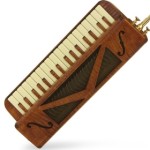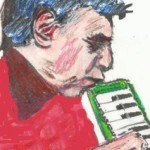Bending Notes
- This topic has 25 replies, 5 voices, and was last updated 9 years, 11 months ago by
 jazzman1945.
jazzman1945.
-
AuthorPosts
-
January 23, 2014 at 10:52 pm #1632
 Alan BrintonParticipant
Alan BrintonParticipantI remembered the term my dentist used, it’s “counter-pressure”.
I’ll be working on trying your technique here in a bit. There’s one other thing I forgot to mention; maybe I’ll make a video of it. Working with the gStrings-Tuner app, I watch the tuner needle while I’m working on bending a note so I can see how far it bends, kind of like bio-feedback.
By the way, I really like your playing in the Soundcloud clips. I didn’t know about Soundcloud. I sent your Irish Melody 2 to my friend Andrew who plays piano on lots of gigs and who is now also playing a Yamaha Pianica P-37D. He’s on his way to Ireland for a week and will probably hit some pubs with his melodica, though Troy’s video gave him second thoughts.
January 24, 2014 at 7:35 pm #1636 Alan BrintonParticipant
Alan BrintonParticipantOkay, Quetscher, I’ve had a chance to experiment with your technique and am happy to report that it works for me. It does make bending easier. So here’s my analysis of what’s happening. I think it has to do with what Jazzman1945 refers to as “the principle of the lever.” Basically, the key is a lever. A lever is often described as having three parts, right? The Fulcrum, the Force applied at one end, and Resistance at the other end. Our finger is at the force end of the melodica key, and the other end opens the the air vent to the reed. One way to make bending easier would be to design the melodica in such a way as to increase resistance at the air vent end. Another way, suggested by Kevin, is to create resistance at the force end by placing our thumb under that end of the key (or, as I suggested, creating friction with our thumb on the front end surface). Another melodica design approach would be to have longer keys. The key is about 3″ long; if that were increased to 6″, the lever would be twice as long, and we’d have more control. There would be trade-offs to a design approach. Your technique, though, adds the length of our finger to the lever, with force now being applied at the wrist joint, adding 6″ or so to the lever and thereby significantly increasing control over the size of the vent opening. Having our other fingers and thumb resting on the keyboard anchors the wrist and stabilizes the finger or thumb with which force is applied. Does this all sound right?
January 24, 2014 at 9:10 pm #1637 QuetscherParticipant
QuetscherParticipantHey Alan,
it took me quite a long time to read your article thoroughly and understand it word by word (I’m not too good at technical terms in english). But now I got the impression that if Kevin is the next Hermeto, you are the ingenius engineer to develop the best melodica the world has ever seen, regarding all our requirements and fullfilling our secret wishes. Again you explained to me theoretically what I tried to find out by practising, and, yes, it sounds completely logical to me.
I personnally would prefer longer keys although this would mean an increase of weight, but for me it’s all about control especially when playing fast. Increasing resistance at the air vent end would mean (am I right?) to take stronger springs, but that would increase the danger of the felt sticking at the edge of the air vent which could lead to an uncontrolled opening (with some melodicas you have the problem that you need a certain power to press the key, and then it opens all of a sudden and you lose control – and I guess this is the result either of sticking keys or sticking felts).
In the forum “Other free reed instruments” you’ll find a topic called “A melodica transformation”. Just a few weeks ago I bought a Hohner harmonium that I want to transform into a Basso melodica (I would go down to the low “C”!). This harmonium works with levers like a Vibrandoneon and has keys of 14cm in length and levers of 13cm, measured from the fulcrum. According to your theory this would mean that bending would be much easier with such an instrument. Well, I can’t predict when I will have finished the transformation, I’m not a good craftsman and need help to do this, but as soon as I have done I will try out bendings and report.
Thanks anyway for believing in my theory and trying out if it works; also thanks for your comment on my recordings.
January 24, 2014 at 10:38 pm #1640 Alan BrintonParticipant
Alan BrintonParticipantFascinating project!
January 25, 2014 at 4:20 am #1643 Alan BrintonParticipant
Alan BrintonParticipantOkay, Quetscher, I’m not sure why this should work, but I’ve made another discovery. I was just trying different things. Without using any other bending technique and blowing directly into the blow tube without a mouthpiece, pucker your lips so that a very fine stream of air is flowing through them and into the melodica. What we’re doing is reducing the size of the hole out of our mouth rather than reducing the size of the vent hole with the key. This will bend the note somewhat, even with the key fully depressed. Now, try it with partial depression of the keys but still without any other bending technique. I had this idea while watching Toots Thielemans play Smile. Okay, here’s a second run at Smile off the tip of my tongue. It’s pretty bad, but you get the idea.
January 25, 2014 at 4:20 am #1644January 25, 2014 at 4:23 am #1645 Alan BrintonParticipant
Alan BrintonParticipantThat’s with the Suzuki A-34C.
January 25, 2014 at 10:22 am #1646 QuetscherParticipant
QuetscherParticipantHey Alan,
I’m quite sure I know how this works, I’ll try to explain but I have to begin a little with Adam and Eve…
What do you need to produce a note on a melodica?
1. You need a reed plate with a slit.
2. You need a reed that is just minimally smaller than this slit and is nailed (screwed, glued, whatever) above that slit.
3. You need air.
Now, what happens physically when a note is played?
The airstream hits the reed on the side where it’s nailed on the plate and makes it swing in a constant frequency depending on the length, thickness, weight, material of the reed. This movement makes the air on the other side of the reed swing in exactly the same frequency, and as we all know, this causes a tone. That’s all, meaning what is wrapped around the plate (an accordion, a harmonica, a melodica…) is of no importance for the production of the tone itself.So, what happens when we want to bend a note?
We try to influence the frequency of the reed in such a way that it swings slower, i.e. the note we play becomes lower. There is JUST ONE WAY to reach this goal, it’s to accelerate the air stream. With this you bring the reed out of its natural position by bending it towards the slit. Now the reed swings its normal way in one direction, but in the other direction it swings a longer way because of the material that wants to force its way back into the natural position (I’m sorry I can’t explain better, there is a name for that physical power but I don’t know it). Fact is, now the reed swings a longer way i.e. it swings slower i.e. the note sounds deeper.Everything we talked about, may it be increasing pressure when blowing, moving the key as little as possible, tightening the air hole by covering it a little with your lips, tongue etc. – all these things only serve to accelerate the air stream. The tinier the hole of the blow tube, the faster the air stream – the tinier the vent hole, the faster the air stream – he bigger the blowing pressure, the faster the air stream. All of those techniques may lead to a bending of the reed and, as a result of that, to a bending of the note.
January 25, 2014 at 6:58 pm #1659 Alan BrintonParticipant
Alan BrintonParticipantThat makes very good sense, Quetscher. Thank you.
May 9, 2014 at 12:53 pm #2254 jazzman1945Participant
jazzman1945ParticipantIn search of bending technique, I also found a few techniques, in addition to what is presented here.Clear that the key must move slowly and shallowly ; so I started using straight elongated finger lying completely flat on the key, and doesn’t move the fingertip, but his first phalanx.
Another type of pressure: turn palm inward, put it on the right of the keyboard, touching the side of the second finger beginning of button, and then SLOWLY rotate the palm inside – outside , without losing touch with the tip of key.Very beautiful bending has Steve Cristofferson , and generally his sound to me – the highest standard!
May 9, 2014 at 12:54 pm #2255 jazzman1945Participant
jazzman1945Participant -
AuthorPosts
- You must be logged in to reply to this topic.
